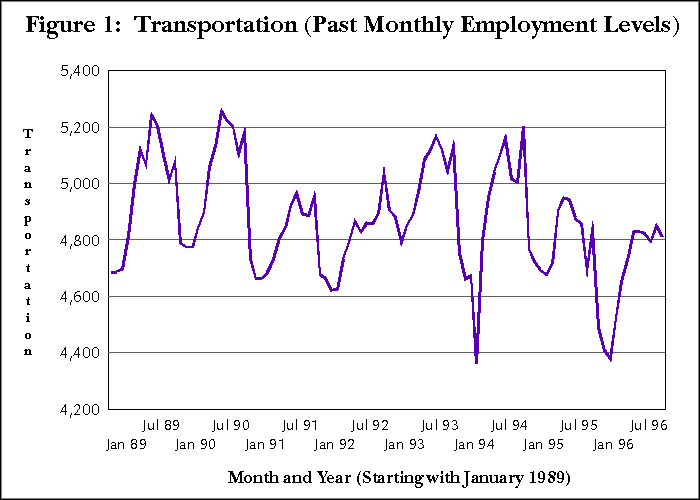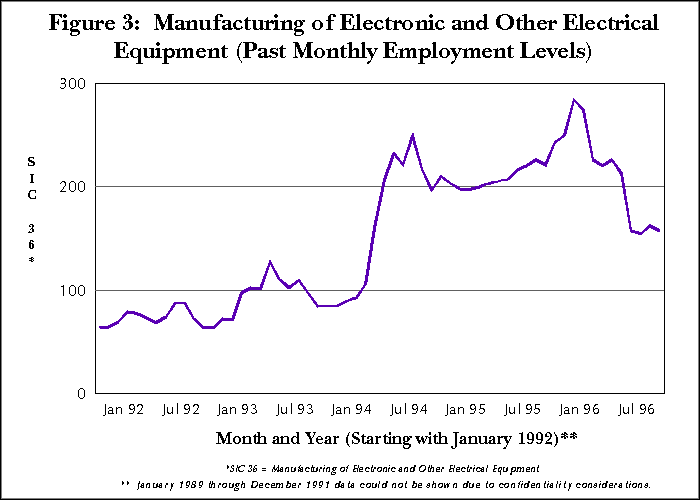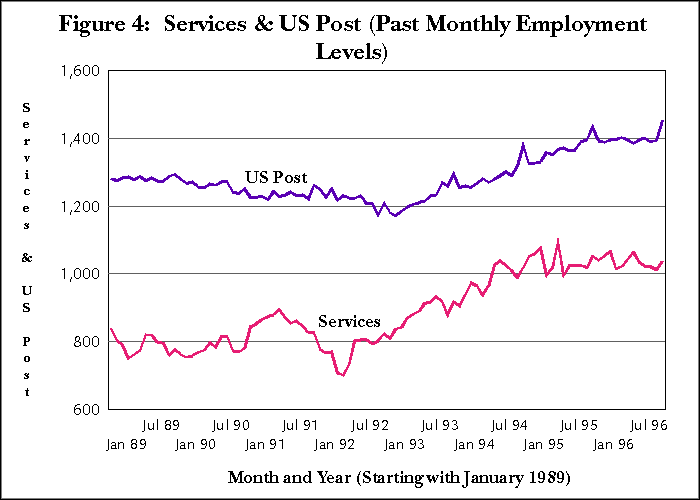 |
Transportation & Information
Industries:
Where Have We Been and Where Are We Going?
by: Norman
Baron
|
The purpose of this article is to describe an initial study of the
Transportation & Information industry. This industry is a subset
of the TCPU (Transportation, Communications, & Public Utilities)
industrial division which is a significant part of Wyoming’s
economic make-up and currently is estimated to employ 13,900 persons.
TCPU contains ten major groups of industries, grouped according to
Standard Industrial Classification (SIC) codes. This study focused
on nine of these groups. The tenth group, that of Public Utilities,
will be the focus of a future article. The nine groups included in
this study were:
-
Railroad Transportation (SIC 40)
-
Local and Suburban Transit and Interurban Highway Passenger
Transportation (SIC 41)
-
Motor Freight Transportation
(SIC 42)
-
United States Postal Service (SIC 43)
-
Water Transportation (SIC 44)
-
Transportation By Air (SIC 45)
-
Pipelines, Except Natural Gas
(SIC 46)
-
Transportation Services (SIC 47)
-
Communications (SIC 48)
The major groups in this industry tend to affect one another to differing
degrees. Some of these influences are positive, some are negative. These
groups also are driven by somewhat different factors. This kind of interaction
between groups makes employment prediction of this Division as a whole difficult.
For these reasons, pairing groups that show similar time series and statistical
characteristics will be used.
In order to organize monthly employment data, establishments are categorized by
industry and each industry is assigned a Standard Industrial Classification
(SIC) code. An establishment’s SIC is periodically evaluated to ensure proper classification. This evaluation may result in a classification change. The employment data for the Freight industry (SIC 42) and the Air Transportation industry (SIC 45) were significantly affected by such a change in January of 1996. In order to keep a valid statistical employment time series for these two industries, they are grouped together and referred to as Transportation. Local and Suburban Transit and Interurban Highway Passenger Transportation and Transportation Services were paired based on similar overall as well as seasonal time series patterns (labeled as "Services" in the Figures). Communications and the United States Postal Service (US Post) compose separate groups.
Transportation is a seasonal industry with the greatest levels of employment
in the summer months when Wyoming roads and runways are more easily traversed
(see Figure 1). There were large declines in the first months of 1994 and
1996; there also tends to be a jump in employment during the month of December
of each year, most likely due to the holiday season. Other industries that
tend to influence or affect employment in Transportation are Oil and a
combination of Oil and Coal employment. These industries have similar time
series patterns with the exception of the December increase.

The Communications group employment was on the decline between mid 1991
and early 1995, but has since shown gains (see Figure 2).
This decline is most likely due to an increase in the use of technology
and consolidation within companies.

Increase in the use of technology
can be shown (see Figure 3) by the increase in
Wyoming’s employment in manufacturing of electronic and other electrical
equipment and components, except in the computer equipment industry (SIC 36).
 It is hypothesized that Services and US Post have a somewhat similar
employment overall time series pattern because they may be influenced by
factors of long term growth such as wholesale trade durable goods (SIC 50);
insurance agents, brokers, and services (SIC 64); and/or home furniture,
furnishings, and equipment stores (SIC 57). In contrast, Services
employment tends to react more quickly to these long term changes in
addition to reacting to other short term factors such as travel demands
(see Figure 4).
It is hypothesized that Services and US Post have a somewhat similar
employment overall time series pattern because they may be influenced by
factors of long term growth such as wholesale trade durable goods (SIC 50);
insurance agents, brokers, and services (SIC 64); and/or home furniture,
furnishings, and equipment stores (SIC 57). In contrast, Services
employment tends to react more quickly to these long term changes in
addition to reacting to other short term factors such as travel demands
(see Figure 4).

In summary, this initial study explored several factors associated with the
Transportation & Information industry. A limitation of this research
was the difficulty encountered in predicting employment even with the use
of paired SIC groups and various statistical techniques. In a continuing
study of this industry, other variables and statistical techniques will be
explored.
Norman Baron is an Economist with Research &
Planning, specializing in Labor Market Information.
This article was published in the Wyoming Labor
Force Trends August 1997 issue.
|